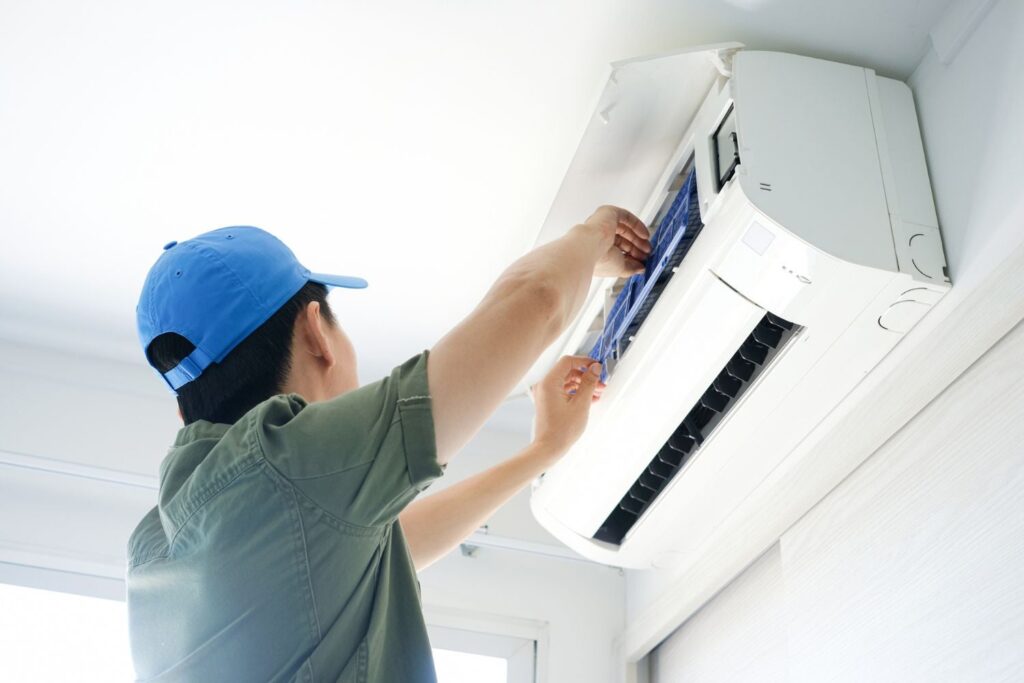To keep your AC running smoothly, start by checking and calibrating the thermostat. Upgrade to a programmable model for better efficiency. Inspect all electrical components, tightening connections and checking for any damage. Regularly replace or clean air filters to maintain good airflow and air quality. Examine and clean the evaporator and condenser coils, making sure there’s no debris. Clear the condensate drain to prevent blockages and water damage. Lastly, assess and maintain proper refrigerant levels to guarantee effective cooling. For detailed steps and additional tips, continue exploring to make sure your AC is in top shape year-round.
Check Thermostat Settings
Start your AC maintenance routine by confirming that your thermostat settings are properly configured for peak performance. First, check that your thermostat is in good working condition. If it’s an older model, consider upgrading to a programmable thermostat for better efficiency. To begin, calibrate the thermostat to make sure it’s accurately reading the room temperature. You can do this by comparing its reading with an accurate thermometer. If there’s a discrepancy, follow your thermostat’s manual to make the necessary adjustments.
Next, program settings that align with your daily schedule. For example, set the temperature higher when you’re not home and lower it just before you return. This helps to reduce energy consumption without sacrificing comfort. Most modern thermostats have ‘smart’ features that learn your preferences and adjust settings automatically over time.
Additionally, ensure the thermostat is placed away from direct sunlight, drafts, and heat-producing appliances. These factors can give false readings and cause your AC to work harder than necessary.
Inspect Electrical Components
 Make sure to inspect the electrical components of your AC unit regularly. Check wiring connections for any signs of wear or looseness, and test the capacitors to make sure they’re functioning properly.
Make sure to inspect the electrical components of your AC unit regularly. Check wiring connections for any signs of wear or looseness, and test the capacitors to make sure they’re functioning properly.
These steps help prevent potential electrical issues and keep your AC running smoothly.
Check Wiring Connections
To guarantee your AC unit runs safely and efficiently, thoroughly inspect all wiring connections for any signs of wear or damage. Start by examining the wiring insulation. Make sure that it’s intact and free from cracks or frays. Damaged insulation can lead to short circuits or even fires, so it’s important to address any issues immediately.
Next, focus on the connection tightness. Loose connections can cause electrical arcing, which not only reduces your AC’s performance but also poses a significant safety risk. Use a screwdriver to tighten any loose screws or terminals. Ensure each connection is secure without over-tightening, which could strip the screws or damage the wiring.
Also, look for any discoloration or burn marks around the wiring and connections. These can be indicators of overheating or electrical issues that need prompt attention. If you notice anything unusual, it might be time to call a professional.
Test Capacitors Functionality
Always verify that your AC capacitors are functioning correctly by testing their ability to store and release electrical energy efficiently. Capacitors play a critical role in starting the compressor and fan motors, and any malfunction could lead to system failure. Over time, capacitors degrade, affecting their performance and shortening their lifespan.
To test capacitors, you’ll need a multimeter with a capacitance setting. First, confirm the AC unit is powered off and unplugged to avoid any electrical hazards. Locate the capacitors, typically found in the outdoor unit’s access panel. Discharge the capacitors by shorting the terminals with an insulated screwdriver.
Set your multimeter to the capacitance setting and connect the probes to the capacitor terminals. Compare the reading with the capacitor’s rated capacitance, usually indicated on its label. If the reading is notably lower than the rated value, it’s time to replace the capacitor. Consistently following these testing procedures ensures your AC system remains reliable and efficient.
Don’t overlook this step in your maintenance routine. Regularly testing and replacing capacitors as needed will extend your AC unit’s lifespan and prevent unexpected breakdowns.
Clean or Replace Filters
Consistently cleaning or replacing your AC filters guarantees ideal airflow and enhances the overall efficiency of the unit. Over time, filters can accumulate dust, pollen, and other particles that restrict airflow and reduce the system’s effectiveness. By addressing the filter lifespan, you make sure that your AC runs smoothly and maintains better air quality in your home.
To begin, check your filter monthly and replace it every one to three months, depending on factors like usage and whether you have pets. A clogged filter makes your AC work harder, leading to higher energy bills and potential system damage. By keeping the filter clean, you not only extend the filter’s lifespan but also improve the air quality by trapping allergens and pollutants.
If your AC uses reusable filters, remove them and rinse them with water, allowing them to dry completely before reinserting. For disposable filters, simply replace them with a new one that matches your unit’s specifications.
Regular attention to your AC filters helps prevent unnecessary strain on the system, ensuring it operates efficiently and effectively all season long. Don’t underestimate the importance of this simple yet vital step in your regular AC maintenance routine.
Examine and Clean Coils
Checking the condition of your AC coils is crucial. Look for any signs of wear and tear, and make sure to remove any debris buildup.
Keeping the coils clean will help your system run efficiently and extend its lifespan.
Check Coil Condition
Examining your AC coils closely and giving them a thorough clean can greatly enhance your unit’s efficiency. First, locate the evaporator and condenser coils; they’re typically behind access panels. Check the coil insulation to confirm it’s intact and not deteriorating. Damaged insulation can lead to improvements and higher energy bills.
Next, inspect the coil fins. These delicate aluminum fins can easily bend, blocking airflow and reducing performance. If you notice any bent fins, use a fin comb to straighten them carefully.
When cleaning the coils, turn off the unit to guarantee safety. A simple way to clean the coil fins is by using a soft brush to remove dust and debris gently. For a deeper clean, you can use a no-rinse coil cleaner spray designed specifically for this purpose. Just spray the cleaner on the coils and let it do its job without the need for rinsing.
Regularly examining and cleaning your AC coils helps maintain improved performance and prolongs the life of your system. By keeping the coils in good condition, you’ll ensure efficient cooling and avoid unnecessary strain on your unit, leading to better energy efficiency and cost savings.
Remove Debris Buildup
Clearing debris buildup from your AC coils is essential to guarantee peak performance and efficiency. The first step is to examine the outdoor unit, as it’s often exposed to dirt, leaves, and other debris. These particles can accumulate on the coils, causing airflow obstruction and reducing your system’s efficiency.
Start by turning off the power to your AC unit to ensure safety. Next, remove the protective grille or cover to access the coils. Use a soft brush or a vacuum cleaner with a soft brush attachment to gently remove loose debris. Be careful not to damage the delicate fins on the coils.
For more stubborn debris, you can use a garden hose with a gentle spray to wash away the dirt. Make sure to spray from the inside out to avoid pushing debris further into the coils. If the buildup is severe, consider using a commercial coil cleaner. Follow the manufacturer’s instructions closely.
Once you’ve cleaned the coils, reassemble the outdoor unit and restore power. This simple maintenance task can greatly improve your AC’s performance, extend its lifespan, and reduce energy consumption.


 Make sure to inspect the electrical components of your AC unit regularly. Check wiring connections for any signs of wear or looseness, and test the capacitors to make sure they’re functioning properly.
Make sure to inspect the electrical components of your AC unit regularly. Check wiring connections for any signs of wear or looseness, and test the capacitors to make sure they’re functioning properly.